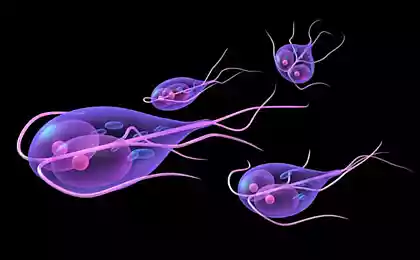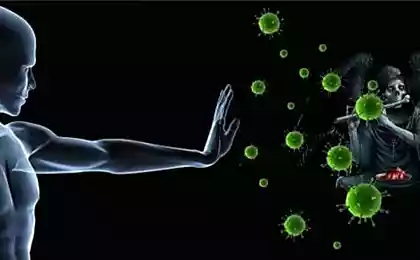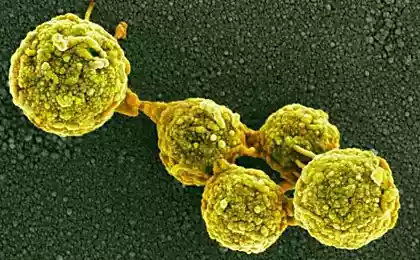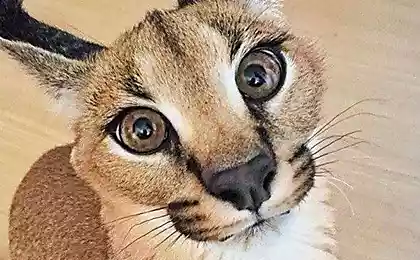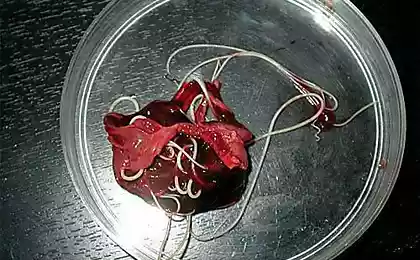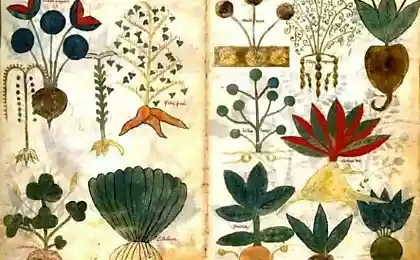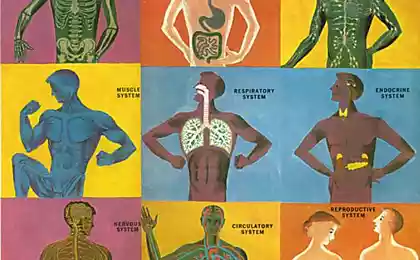560
Parasites that control the behavior of the owners
We are accustomed to the fact that the parasite is a creature which exists at the expense of the owner. There are instances that are in a position to decide when the owner should die. However, there are parasites which change how the physiology and behavior of the owners. This article will introduce You to the parasite manipulators.
Myrmeconema neotropicum. Fifty four million eight hundred sixty three thousand fifty seven
Nematode Myrmeconema neotropicum exist by ants of the species Cephalotes atratus. They are capable of incredible force the ants to become more like a berry. These ants live in tropical forests, which grows berries that are red. Tricky nematode uses this outside factor and changes the rear part of the insect, turning it into a "berry". Of course, when the parasite settles in the host, it makes it sluggish and clumsy, making it easy prey for birds that feed on the berries.
Leucochloridium paradoxum. Forty seven million seven hundred eighty seven thousand seven hundred sixty one
This parasite prefers to spend time in the body of birds. And they kind of don't mind. Leucochloridium paradoxum is a flatworm, which is the whole digestive tract of birds and leaves together with egg. Then the following occurs: a baby bird hatches, and eats the shell of a snail. Larva flat worm lives in the body of the snail and develops to sporocyst (the next stage). Reproduced sporocyst way down the eye stalks of snails and turn them into something that is similar to the green-yellow caterpillars. As is known, such a treat to prefer birds.
Hymenoepimecis argyraphaga. Fifty three million one hundred fifty six thousand two hundred twenty four
This parasite lives in Costa Rica. Hymenoepimecis argyraphaga is a parasitic wasp. It exists due to the spider Plesiometa argyra species. When the parasite needs to lay eggs, she paralyzes the spider and lays his offspring on his belly. The larva hatches and begins to eat the spider. And he, in turn, continues to live their usual everyday life. It takes a few weeks. Then the larva begins to excrete in the body of a spider certain substances that affect the web. The spider begins to weave a web, which is absolutely not typical of his species. In appearance, of course, she's quite attractive, but very durable and able to withstand any weather conditions. After that, the larva just kills the spider and builds a cocoon inside the woven web host.
Lanceolate Fluke. Twenty eight million seven hundred forty thousand one hundred seventy eight
The adult parasite lives in the liver of cattle. In the body the parasite lays eggs, which come from the feces of the animal. Them eat snails. Small larvae hatch already in the digestive system of a snail. When it's time, these larvae come to the surface owner, and the fright snail secretes mucus, which drains to the ground. This is exactly what the parasite. This slime is eaten by ants. In the body of an ant parasite on his way to the head master. When twilight comes, the ant controlled the larvae and force it not to return to the anthill. Instead, the insect pauses on a blade of grass and dutifully waiting for the dawn to be eaten along with the grass the cattle in the pasture. If suddenly the ant is not eaten, the parasites "released" it, that is no longer in control, and allow you to go about your daily routines. And at night again under control. And so until then while it will not eat.
Heterorhabditis bacteriophora. Three million eight hundred seventy thousand three hundred forty eight
The behavior of this parasite can be considered unique. They do not force the owner to walk straight into the jaws of predators, and Vice versa – predators fail. Nematodes of this parasite affect insect larvae. The host body changes color from white to red. This color carries the warning "warning! Dangerously!". The fact that the parasite lives and feeds from the larvae and it is not profitable to the master, something happened. After all, if you die, the host dies and the parasite.
Sacculina carcini. Seventy six million four hundred twenty five thousand eight hundred thirty five
These parasites begin their existence as small larvae are free swimming. But it is worth it to find the owner of ways, from increase in size. Cancer begin to colonize the females: they are attached to the lower part of the host and form its shell convexity. After that, the female extends along the body of the crab antennae, which are designed to absorb nutrients. The growth of the parasite growing bulge and soon resembles a large cone. Only then there can be hooked by the male parasite. But then begins the pairing process Sacculina carcini. Crustaceans becomes a normal slave and is only for parasites. It will stop growing, and existence is to care for the parasite eggs as if they were his own. I must say that these parasites take only males of crustaceans. In all the time that his body is inhabited by parasites, host body is changed in an incredible way. First, Sacculina carcini a sterilized male, and then change the body settings to the female: the stomach align and expand. This leads to the fact that the body produces certain hormones that force them to change the behavior of the male host. He starts to behave exactly like the female of its kind, and even performs mating dance in front of other males.
Toxoplasma gondii. Forty four million nine hundred ninety thousand nine hundred twenty nine
Such rodents as rats, good to distinguish the smell of urine of cats and avoided places that smell of it. Toxoplasma gondii is a unicellular parasite that infects rodents. In this case, the rat completely loses its instincts. The most disgusting parasite that causes rodent experience almost no sexual attraction to previously dangerous smell. Simply put, a single cell does to a cat caught an infected rat. And all because the body of the cat is the best place for the reproduction of Toxoplasma gondii.
Spinochordodes tellinii. Seventy four million three hundred eighty three thousand eight hundred eleven
This species prefers crickets and grasshoppers. Adults breed in water and there live. The larvae enter the insect body through the water while drinking. Already in the host's body they grow to a certain age. And then just vpryskivat poison in the body of an insect, which attacks the nervous system. For example, the grasshopper ceases to control his movements and sent a parasite, jumping into the water, where he drowns. After the suicide of the owner, an adult parasite quietly leaves his body and it all starts again.
The fungus ophiocordyceps. Eighty five million two hundred five thousand two hundred twenty nine
There are species of ants that build nests in the trees. On the ground they go only in search of food. This continues until the appearance of this parasite. Once in the insect body, the fungus literally controls the host. Under his influence, the ant leaves the nest and reaching the ground, hangs on a leaf or branch, clinging only jaw. In this position, hanging until death. In the meantime, the fungus is a parasite develops quietly, feeding on host tissues. It destroys not only the muscles that are responsible for the operation of the jaw. And so it lives in the dead host's body for several weeks, and then spores fall to the ground and infect new ants.
Glyptapanteles. Thirty three million four hundred seventy thousand two hundred forty eight
This wasp parasites. They infect the caterpillars of the species Thyrinteina leucocerae. It all starts with the fact that the wasps lay their eggs in the body of a newborn caterpillar. Small larvae begin their lives in the host's body. When the parasite larvae grow, they leave the body of the caterpillar and pupate nearby. Even despite the fact that the parasite is outside the host's body, their relationship somehow inexplicably still remains: the caterpillar eats and takes care of the parasites, wrapping them with silk. But if suddenly on the horizon appears a predator, the caterpillar will do everything possible to protect parasitic wasps. published
P. S. And remember, only by changing their consumption — together we change the world! ©
Join us in Facebook and in Vkontakte, and we're Classmates
Source: mif-facts.com.ua
Myrmeconema neotropicum. Fifty four million eight hundred sixty three thousand fifty seven
Nematode Myrmeconema neotropicum exist by ants of the species Cephalotes atratus. They are capable of incredible force the ants to become more like a berry. These ants live in tropical forests, which grows berries that are red. Tricky nematode uses this outside factor and changes the rear part of the insect, turning it into a "berry". Of course, when the parasite settles in the host, it makes it sluggish and clumsy, making it easy prey for birds that feed on the berries.
Leucochloridium paradoxum. Forty seven million seven hundred eighty seven thousand seven hundred sixty one
This parasite prefers to spend time in the body of birds. And they kind of don't mind. Leucochloridium paradoxum is a flatworm, which is the whole digestive tract of birds and leaves together with egg. Then the following occurs: a baby bird hatches, and eats the shell of a snail. Larva flat worm lives in the body of the snail and develops to sporocyst (the next stage). Reproduced sporocyst way down the eye stalks of snails and turn them into something that is similar to the green-yellow caterpillars. As is known, such a treat to prefer birds.
Hymenoepimecis argyraphaga. Fifty three million one hundred fifty six thousand two hundred twenty four
This parasite lives in Costa Rica. Hymenoepimecis argyraphaga is a parasitic wasp. It exists due to the spider Plesiometa argyra species. When the parasite needs to lay eggs, she paralyzes the spider and lays his offspring on his belly. The larva hatches and begins to eat the spider. And he, in turn, continues to live their usual everyday life. It takes a few weeks. Then the larva begins to excrete in the body of a spider certain substances that affect the web. The spider begins to weave a web, which is absolutely not typical of his species. In appearance, of course, she's quite attractive, but very durable and able to withstand any weather conditions. After that, the larva just kills the spider and builds a cocoon inside the woven web host.
Lanceolate Fluke. Twenty eight million seven hundred forty thousand one hundred seventy eight
The adult parasite lives in the liver of cattle. In the body the parasite lays eggs, which come from the feces of the animal. Them eat snails. Small larvae hatch already in the digestive system of a snail. When it's time, these larvae come to the surface owner, and the fright snail secretes mucus, which drains to the ground. This is exactly what the parasite. This slime is eaten by ants. In the body of an ant parasite on his way to the head master. When twilight comes, the ant controlled the larvae and force it not to return to the anthill. Instead, the insect pauses on a blade of grass and dutifully waiting for the dawn to be eaten along with the grass the cattle in the pasture. If suddenly the ant is not eaten, the parasites "released" it, that is no longer in control, and allow you to go about your daily routines. And at night again under control. And so until then while it will not eat.
Heterorhabditis bacteriophora. Three million eight hundred seventy thousand three hundred forty eight
The behavior of this parasite can be considered unique. They do not force the owner to walk straight into the jaws of predators, and Vice versa – predators fail. Nematodes of this parasite affect insect larvae. The host body changes color from white to red. This color carries the warning "warning! Dangerously!". The fact that the parasite lives and feeds from the larvae and it is not profitable to the master, something happened. After all, if you die, the host dies and the parasite.
Sacculina carcini. Seventy six million four hundred twenty five thousand eight hundred thirty five
These parasites begin their existence as small larvae are free swimming. But it is worth it to find the owner of ways, from increase in size. Cancer begin to colonize the females: they are attached to the lower part of the host and form its shell convexity. After that, the female extends along the body of the crab antennae, which are designed to absorb nutrients. The growth of the parasite growing bulge and soon resembles a large cone. Only then there can be hooked by the male parasite. But then begins the pairing process Sacculina carcini. Crustaceans becomes a normal slave and is only for parasites. It will stop growing, and existence is to care for the parasite eggs as if they were his own. I must say that these parasites take only males of crustaceans. In all the time that his body is inhabited by parasites, host body is changed in an incredible way. First, Sacculina carcini a sterilized male, and then change the body settings to the female: the stomach align and expand. This leads to the fact that the body produces certain hormones that force them to change the behavior of the male host. He starts to behave exactly like the female of its kind, and even performs mating dance in front of other males.
Toxoplasma gondii. Forty four million nine hundred ninety thousand nine hundred twenty nine
Such rodents as rats, good to distinguish the smell of urine of cats and avoided places that smell of it. Toxoplasma gondii is a unicellular parasite that infects rodents. In this case, the rat completely loses its instincts. The most disgusting parasite that causes rodent experience almost no sexual attraction to previously dangerous smell. Simply put, a single cell does to a cat caught an infected rat. And all because the body of the cat is the best place for the reproduction of Toxoplasma gondii.
Spinochordodes tellinii. Seventy four million three hundred eighty three thousand eight hundred eleven
This species prefers crickets and grasshoppers. Adults breed in water and there live. The larvae enter the insect body through the water while drinking. Already in the host's body they grow to a certain age. And then just vpryskivat poison in the body of an insect, which attacks the nervous system. For example, the grasshopper ceases to control his movements and sent a parasite, jumping into the water, where he drowns. After the suicide of the owner, an adult parasite quietly leaves his body and it all starts again.
The fungus ophiocordyceps. Eighty five million two hundred five thousand two hundred twenty nine
There are species of ants that build nests in the trees. On the ground they go only in search of food. This continues until the appearance of this parasite. Once in the insect body, the fungus literally controls the host. Under his influence, the ant leaves the nest and reaching the ground, hangs on a leaf or branch, clinging only jaw. In this position, hanging until death. In the meantime, the fungus is a parasite develops quietly, feeding on host tissues. It destroys not only the muscles that are responsible for the operation of the jaw. And so it lives in the dead host's body for several weeks, and then spores fall to the ground and infect new ants.
Glyptapanteles. Thirty three million four hundred seventy thousand two hundred forty eight
This wasp parasites. They infect the caterpillars of the species Thyrinteina leucocerae. It all starts with the fact that the wasps lay their eggs in the body of a newborn caterpillar. Small larvae begin their lives in the host's body. When the parasite larvae grow, they leave the body of the caterpillar and pupate nearby. Even despite the fact that the parasite is outside the host's body, their relationship somehow inexplicably still remains: the caterpillar eats and takes care of the parasites, wrapping them with silk. But if suddenly on the horizon appears a predator, the caterpillar will do everything possible to protect parasitic wasps. published
P. S. And remember, only by changing their consumption — together we change the world! ©
Join us in Facebook and in Vkontakte, and we're Classmates
Source: mif-facts.com.ua







